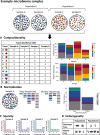Microbiome Multi-Omics Network Analysis: Statistical Considerations, Limitations, and Opportunities
- PMID: 31781153
- PMCID: PMC6857202
- DOI: 10.3389/fgene.2019.00995
Microbiome Multi-Omics Network Analysis: Statistical Considerations, Limitations, and Opportunities
Abstract
The advent of large-scale microbiome studies affords newfound analytical opportunities to understand how these communities of microbes operate and relate to their environment. However, the analytical methodology needed to model microbiome data and integrate them with other data constructs remains nascent. This emergent analytical toolset frequently ports over techniques developed in other multi-omics investigations, especially the growing array of statistical and computational techniques for integrating and representing data through networks. While network analysis has emerged as a powerful approach to modeling microbiome data, oftentimes by integrating these data with other types of omics data to discern their functional linkages, it is not always evident if the statistical details of the approach being applied are consistent with the assumptions of microbiome data or how they impact data interpretation. In this review, we overview some of the most important network methods for integrative analysis, with an emphasis on methods that have been applied or have great potential to be applied to the analysis of multi-omics integration of microbiome data. We compare advantages and disadvantages of various statistical tools, assess their applicability to microbiome data, and discuss their biological interpretability. We also highlight on-going statistical challenges and opportunities for integrative network analysis of microbiome data.
Keywords: compositionality; heterogeneity; microbiome networks; multi-omics data integration; network analysis; normalization; sparsity.
Copyright © 2019 Jiang, Armour, Hu, Mei, Tian, Sharpton and Jiang.
Figures

Similar articles
-
Computational Approaches for Integrative Analysis of the Metabolome and Microbiome.Metabolites. 2017 Nov 18;7(4):62. doi: 10.3390/metabo7040062. Metabolites. 2017. PMID: 29156542 Free PMC article. Review.
-
Computational approaches for network-based integrative multi-omics analysis.Front Mol Biosci. 2022 Nov 14;9:967205. doi: 10.3389/fmolb.2022.967205. eCollection 2022. Front Mol Biosci. 2022. PMID: 36452456 Free PMC article. Review.
-
Progress on network modeling and analysis of gut microecology: a review.Appl Environ Microbiol. 2024 Mar 20;90(3):e0009224. doi: 10.1128/aem.00092-24. Epub 2024 Feb 28. Appl Environ Microbiol. 2024. PMID: 38415584 Free PMC article. Review.
-
Dynamic Bayesian Networks for Integrating Multi-omics Time Series Microbiome Data.mSystems. 2021 Mar 30;6(2):e01105-20. doi: 10.1128/mSystems.01105-20. mSystems. 2021. PMID: 33785573 Free PMC article.
-
Network-based multi-omics integrative analysis methods in drug discovery: a systematic review.BioData Min. 2025 Mar 28;18(1):27. doi: 10.1186/s13040-025-00442-z. BioData Min. 2025. PMID: 40155979 Free PMC article. Review.
Cited by
-
Spatiotemporal Dynamics of Maize (Zea mays L.) Root Growth and Its Potential Consequences for the Assembly of the Rhizosphere Microbiota.Front Microbiol. 2021 Mar 17;12:619499. doi: 10.3389/fmicb.2021.619499. eCollection 2021. Front Microbiol. 2021. PMID: 33815308 Free PMC article. Review.
-
Early Succession of Community Structures and Biotic Interactions of Gut Microbes in Eriocheir sinensis Megalopa after Desalination.Microorganisms. 2024 Mar 11;12(3):560. doi: 10.3390/microorganisms12030560. Microorganisms. 2024. PMID: 38543611 Free PMC article.
-
Artificial Intelligence (AI)-Based Systems Biology Approaches in Multi-Omics Data Analysis of Cancer.Front Oncol. 2020 Oct 14;10:588221. doi: 10.3389/fonc.2020.588221. eCollection 2020. Front Oncol. 2020. PMID: 33154949 Free PMC article. Review.
-
Meta-analysis of microbiome association networks reveal patterns of dysbiosis in diseased microbiomes.Sci Rep. 2022 Oct 19;12(1):17482. doi: 10.1038/s41598-022-22541-1. Sci Rep. 2022. PMID: 36261472 Free PMC article.
-
Links between Nutrition, Infectious Diseases, and Microbiota: Emerging Technologies and Opportunities for Human-Focused Research.Nutrients. 2020 Jun 19;12(6):1827. doi: 10.3390/nu12061827. Nutrients. 2020. PMID: 32575399 Free PMC article. Review.
References
-
- Albayrak L., Khanipov K., Golovko G., Fofanov Y. (2018). Detection of multi-dimensional co-exclusion patterns in microbial communities. Bioinformatics (Oxford, England). 34, 3695–3701. org/ 10.1093/bioinformatics/bty414 - PubMed
-
- Alivisatos A. P., Blaser M. J., Brodie E. L., Chun M., Dangl J. L., Donohue T. J., et al. (2015). A unified initiative to harness Earth’s microbiomes. Science. 350, 507–508. org/ 10.1126/science.aac8480 - PubMed
Publication types
Grants and funding
LinkOut - more resources
Full Text Sources

